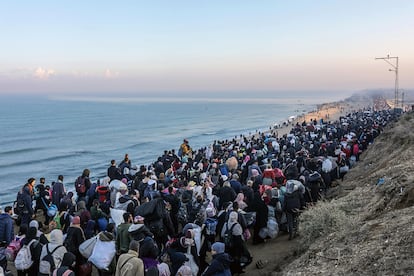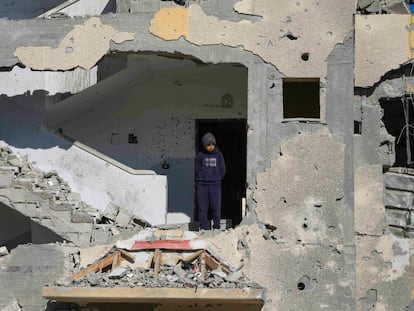Thousands of Palestinians return to northern Gaza after more than a year: ‘We have lived through hell!’
Israel has permitted the return of displaced people to the northern part of the territory following an agreement for an extraordinary exchange of Israeli hostages for Palestinian prisoners, scheduled for Thursday

It was one of the most anticipated moments of the war. Despite the immense destruction they encountered along the way, thousands of people began crossing towards the northern part of the Gaza Strip early on Monday, for the first time in months — many celebrating the feat as a victory.
“We want to rest. We’ve suffered so much. We want to live in peace,” says Husam, a 55-year-old father, through text messages. He hopes to return to Gaza City soon, from which he fled in October 2023 following Israel’s bombings.
The Gazans returning are doing so thanks to a new agreement between Hamas and Israel under the ceasefire framework. On Thursday, a hostages exchange will occur, with Israeli Arbel Yehud being swapped for Palestinian prisoners, a provision not included in the original ceasefire agreement. The Israeli government of Benjamin Netanyahu claimed over the weekend that Yehud should have already been released.
Some Gazans had been stranded for hours on the road, as they initially expected to be able to return home on Sunday. However, Israeli occupation troops have now allowed them to pass through to northern towns within the enclave, such as Gaza City, Jabalia, Beit Lahia, and Beit Hanoun.
Images received by news agencies show most of them advancing on foot, passing through Israeli military checkpoints along the so-called Netzarim corridor, which the military has used to divide the Gaza Strip in two. On one side, they are taking the road running parallel to the Mediterranean coast, Rashid Street, while on the other side, they are traveling along the road parallel to the separation fence between Gaza and Israel, Salahadin Street.
Videos show Gazans being greeted on the coast by armed Hamas militants shouting “Allah is great!” This latest mass movement of citizens comes just hours after the new U.S. president, Donald Trump, proposed “cleaning out” Gaza by sending 1.5 million inhabitants to Egypt and Jordan — his most controversial statement for the Middle East after playing a key role in achieving the ceasefire.
“We’ve been through hell,” says Husam, who prefers to keep his last name private. He uses the past to cling to the hope the ceasefire offers him. Along with his family — his wife, mother, and five children — he has been living in a tent for months in Deir el Balah, located in the central part of the Gaza Strip. After having changed shelter more than half a dozen times in different parts of Gaza, he is now preparing to journey back to his home in the Shati refugee camp in Gaza City.
“Thank God we are still alive, but the destruction is horrible,” adds Husam, speaking from a tent in the Al Mawasi camping area that also serves as a cybercafé, located about 200 meters from the hut where he lives with his family. He knows his home is damaged, but not completely destroyed, and they expect to be able to recover it soon. Unlike many others, who live in a territory where about 70% of homes have been destroyed or damaged, according to U.N. data, Husam and his family will be able to rebuild their home. Many others believe they will have to settle in makeshift camps, even if it is in their place of origin — as has happened in the south of Gaza.
Husam and his family will carry only the essentials: documents, clothes, food, and water. He recalls the weight of the missing: “relatives, friends, and neighbors,” adding to the more than 47,000 dead, mostly women and minors, who have lost their lives in the conflict. The distance between Deir el Balah and Shati is only about 20 kilometers, but any movement within Gaza is unpredictable and fraught with problems.
What Husam fears most about their displacement is the journey for his 79-year-old mother, originally from the Palestinian city of Jaffa, now absorbed into the metropolitan area of Tel Aviv in Israel. During the Nakba (catastrophe) in 1948, she was among the thousands expelled during the war that led to Israel’s independence. “I’ll help her, and we’ll rest along the way. She has lived through many wars,” says Husam, referring not only to her years in Gaza, where Israeli conflicts, incursions, and attacks against Palestinian armed groups are common, but also to the years she lived in Kuwait, where she saw the 1990 invasion by Iraq.
Once they manage to return to Gaza City and settle in their home, they will face the daunting challenge of rebuilding their lives in a devastated territory where the basics — hospitals, schools, universities, and shops — are now part of the past, of the pre-war Gaza Strip. “People are fed up with the tents,” Husam explains, adding that many have “spent their savings on cans [of food], renting apartments, or traveling expenses.” He estimates that poverty has surged to 90%. “Gaza is now more expensive than Madrid,” he says. He himself has lived through “a hell of hunger and illness” due to the dire living conditions and lack of food.
War crimes
Hundreds of thousands of people have been displaced towards the center and south of Gaza since the fighting began in October 2023, and this flow is expected to continue in the coming days if the ceasefire holds. According to Human Rights Watch (HRW), these forced population movements constitute war crimes and crimes against humanity by the Israeli authorities.
The highly anticipated exchange of hostages for Palestinian prisoners, which will facilitate the return of Palestinians to the north, is set to take place on Thursday, as announced by Netanyahu. This exchange will involve three hostages, at least two of whom are women, including Yehud and soldier Agam Berger. The four female military companions of Berger were freed by Hamas and returned to Israel over the weekend.
On Saturday, February 1, the regular pace of releases, as outlined in the ceasefire agreement, will resume with three more hostages. The ceasefire agreement includes the release of 33 captives in the first phase, which is set to last six weeks. Each release of hostages will be accompanied by the release of dozens of Palestinian prisoners held in Israeli prisons.
Netanyahu described Thursday’s exchange agreement as a “backpedal” by the Palestinian Islamist movement, claiming that Yehud should have been released earlier. In addition, Israel announced that Hamas had provided a list detailing the status of the remaining hostages — whether they are alive or dead — who must be released during the remainder of the first phase.
Amid the devastation caused by the conflict, the majority of Gaza’s population is simply hoping for a return to normalcy. However, for that to happen, the fragile ceasefire must hold, and a lengthy and difficult reconstruction process must follow. As Husam explains: “Gaza was beautiful, but now it is just rubble.”
Sign up for our weekly newsletter to get more English-language news coverage from EL PAÍS USA Edition
Tu suscripción se está usando en otro dispositivo
¿Quieres añadir otro usuario a tu suscripción?
Si continúas leyendo en este dispositivo, no se podrá leer en el otro.
FlechaTu suscripción se está usando en otro dispositivo y solo puedes acceder a EL PAÍS desde un dispositivo a la vez.
Si quieres compartir tu cuenta, cambia tu suscripción a la modalidad Premium, así podrás añadir otro usuario. Cada uno accederá con su propia cuenta de email, lo que os permitirá personalizar vuestra experiencia en EL PAÍS.
¿Tienes una suscripción de empresa? Accede aquí para contratar más cuentas.
En el caso de no saber quién está usando tu cuenta, te recomendamos cambiar tu contraseña aquí.
Si decides continuar compartiendo tu cuenta, este mensaje se mostrará en tu dispositivo y en el de la otra persona que está usando tu cuenta de forma indefinida, afectando a tu experiencia de lectura. Puedes consultar aquí los términos y condiciones de la suscripción digital.
More information
Archived In
Últimas noticias
All the effects of gentrification in one corner of Mexico’s Colonia Roma
Palestinian reporter Youmna El Sayed: ‘My family told me I had to choose between being a journalist or a mother’
Christmas loses its festive spirit: ICE fears cast shadow over religious celebrations
The new language of the workplace: Knowing how to ask AI questions is more important than using it
Most viewed
- The low-cost creative revolution: How technology is making art accessible to everyone
- Families demand repatriation of bodies of Colombians who died in Ukraine: ‘This war is a slaughterhouse for foreigners’
- Christian Louboutin: ‘Young people don’t want to be like their parents. And if their parents wear sneakers, they’re going to look for something else’
- US sanctions against jailed cartel leader ‘El Marro’ highlight Mexico’s lack of control over its prisons
- Liset Menéndez de la Prida, neuroscientist: ‘It’s not normal to constantly seek pleasure; it’s important to be bored, to be calm’










































